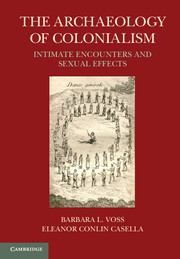Book contents
- Frontmatter
- Contents
- List of Illustrations
- List of Tables
- List of Contributors
- One Intimate Encounters
- Two Sexual Effects
- Section I Pleasures and Prohibitions
- Three Little Bastard Felons
- Four The Currency of Intimacy
- Five “A Concubine is Still a Slave”
- Six The Politics of Reproduction, Rituals, and Sex in Punic Eivissa
- Section II Engaged Bodies
- Section III Commemorations
- Section IV Showing and Telling
- Conclusion
- Index
- References
Four - The Currency of Intimacy
Transformations of the Domestic Sphere on the Late-Nineteenth-Century Diamond Fields
from Section I - Pleasures and Prohibitions
Published online by Cambridge University Press: 05 June 2012
- Frontmatter
- Contents
- List of Illustrations
- List of Tables
- List of Contributors
- One Intimate Encounters
- Two Sexual Effects
- Section I Pleasures and Prohibitions
- Three Little Bastard Felons
- Four The Currency of Intimacy
- Five “A Concubine is Still a Slave”
- Six The Politics of Reproduction, Rituals, and Sex in Punic Eivissa
- Section II Engaged Bodies
- Section III Commemorations
- Section IV Showing and Telling
- Conclusion
- Index
- References
Summary
Introduction
Historical archaeology is always a story about some manner of production and reproduction. Its sites consist of factories, mills, bunker houses, and plantations – spaces where people come together to create more and more things – and, in the process, such sites carve out spaces for the concretions of race, gender, ethnicity, class, and domesticity. Somewhere in all of this, people continually made each other too: reproduction, at its most biologically essential, did not pause for the onset of industrialization, colonization, or nationalism, even as it was often radically rescripted by these same processes. To consider the materiality and artifact record of these sorts of intimate solidarities, affective ties such as motherhood, sexual attraction, burgeoning masculinities, carnal encounters, or the attrition of marital ties in the colonies can often present a tremendous challenge to the archaeologist, particularly because the trails of such enactments are often ephemeral. The presumption of ephemerality in itself, however, arouses some archaeological suspicion, because it raises the question of what concepts (such as gender or reproduction) could possibly mean outside of their colonial housing (Voss 2000); prison-house currencies (Casella 2000); gendered prohibitions according to monastic, missionary, or prison spatialities (Gilchrist 1994); privileged parceling according to factory hierarchy (Hardesty 1998); or integration with spiritual practice (Meskell 1999). Intimacy, sex, and reproduction can only ever occur in, on, and for something – existing within a mesh of what Anna Tsing might include in what she calls ‘frictions’ (Tsing 2005), those encounters with existing infrastructures, the contingencies of physical conditions and the particular ordering of things at any one historical moment, which often collectively redirect global engendering, in ‘queer’ sorts of directions.
The various historically normative categories for procreative and sensual gratification or the extent to which these behaviors could be collapsed with gender or the institution of marriage have always been predicated on the contingencies of historical conditions and the mesh of biopower that any one couple find themselves within. In the colonial context, these proscriptive mores surrounding sex and marriage often came to take on a life of their own, and these institutions were really functioning at a rupture from what might otherwise be read as an uninterrupted historical ontology tracing back to a Christian European genealogy (Povinelli 2007; Taylor 2007). This disjuncture between metropolitan prescriptions for intimacy and love (and all of the subtle injunctions and political forms they mobilized) and how these relationships came to manifest themselves, indicates a good deal about what was at stake, politically, in settler colonies. As Beth Povinelli claims, it is,
the intimate couple [that] is a key transfer point between, on the one hand, liberal imaginaries of contractual economics, politics and sociality, and, on the other, liberal forms of power in the contemporary world. Love, as an intimate event, secures the self-evident good of social institutions, social distributions of life and death, and social responsibilities for these institutions and distributions. If you want to locate the hegemonic home of liberal logics and aspirations, look to love in settler colonies. (Povinelli 2006: 17)
- Type
- Chapter
- Information
- The Archaeology of ColonialismIntimate Encounters and Sexual Effects, pp. 49 - 66Publisher: Cambridge University PressPrint publication year: 2011
References
- 2
- Cited by



